

Nethack is a roguelike. That is: a game resembling Rogue. Rogue was the original ASCII dungeon-crawling game, ported to many OSes, and formerly part of the Linux (and BSD?) package "bsdgames". So when I found it, now as a separate package, while putting some fun & games into a Linux Mint installation, my curiosity was piqued. I installed it, tried it and became more addicted to it than to any of its successors.
This is because it falls in the "coffeebreak roguelikes" category: games that can simply be fired up and played for a few minutes, after which your character will generally die anyway. Rogue has ultimate simplicity: no pets, no praying, no stats except strength, no nested containers (so your "pack" is full pretty quickly), only as much monsters as there are letters in the alphabet, and the keys for getting around should be familiar to those who use vi. The dungeon layout of seven or less rooms per level fits nicely in a small terminal screen. The commands, displayed by typing "?", also fit in one small screen. Gold is useless as there are no shops, and only matters for the score, but out of a compulsive neatness, I pick it up anyway. Out of the same compulsive neatness, I throw unused armour and weapons, and empty wands, at monsters, because a hit means the item disappears. After descending into the next level, the last level seems to be gone, but the purpose is to find the Amulet of Yendor and take it back up to the surface, so the stairways will probably reappear if I ever make it to the bottom. The deepest I've ever gone is level 18; usually I'm dead by level 9, when my own level is lower than that of the monsters I meet. (There are no tame or peaceful monsters, although some are asleep and some don't immediately attack.) The points needed for levelling up keep doubling: the first rise in level happens after 10 experience points, then after 20, then 40, 80, 160, 320 and so on. So after a few levels down, my own level starts to lag behind. Still, I have to make my way down quickly in search of food, because with no shops or edible monster corpses, starvation is a likely fate. It is an essential characteristic of roguelikes that new and different dungeon levels are generated each time a new game is started. The first four levels of Rogue are easy as pie, unless the room full of treasures and monsters that is found on some level or other, has been generated on the first or second level. Or if the adventurer starts the game in a room with three monsters in it. That usually ends my game pretty quickly. (Note: although I can't speak from experience, it seems that 12 experience levels is all you get, versus 26 dungeon levels.)
Two oddities about Rogue: first, if I have 20 arrows in my pack and move over 1 arrow (and auto-pickup is on, which it is by default), I get a message of "21 arrows". No, I did not just pick up 21 arrows. That was the new total in my pack. For gold, the message only states how many pieces were picked up, but then gold is not an inventory item. Second, the save game "rogue.save" is stored in whatever directory I happened to be in when I typed "rogue" in the console, so if I happened to be in a directory where I don't have write rights, tough luck! Clearly, this game was written in a time when people worked on mainframes and had no business to be anywhere but in their own home directories. Continuing a game is done by typing "rogue rogue.save". Not an oddity, but still odd: the descriptions of unidentified rings includes a "stantabolite ring". That's the fanciest description I've seen yet.
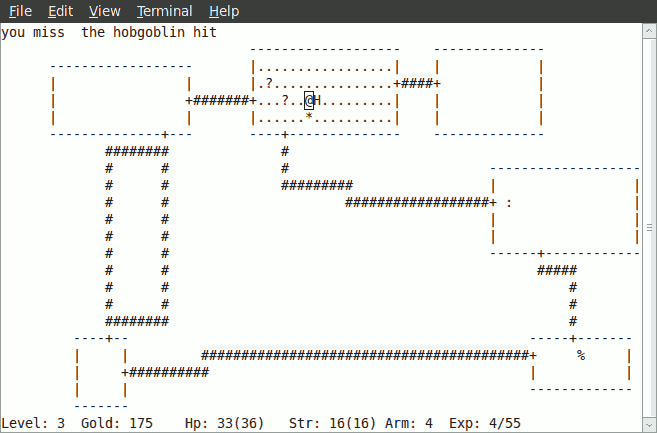
Rogue, simple and basic
Encouraged by this gaming experience, I wanted to try out and compare all roguelikes. But a page listing roguelikes (see Dungeondweller) showed me that not only is this impractical - there are hundreds of them - but not all are set into the same world. Do I really want to play in a "steampunk" setting? So I stuck with the games that are readily found in repositories and installed as packages (something that can't yet be said about the Vultures'): Angband, Crawl and ToME. Like Rogue, these are ASCII and started not from the menu, but by typing "angband", "crawl" or "tome" in a console. Unlike Rogue, they have large game screens and use colours. And despite (or because of?) their greater complexity, none of them addicted me.
The first roguelike derivative was (U)Moria, which was based on Tolkien's world, followed by the similarly Tolkien-based Angbandand its clones, followed in turn by ToME, "Troubles of Middle Earth". I've read that Angband, where the objective is to get to the bottom of the dungeon to defeat Morgoth, packs 100 dungeon levels into the game. I've also heard that Angband is infamous for "grind" - much repetition for the sake of levelling up - and lastly, that its players consider savescumming "a more serious form of abuse" than stairscumming; proof that the humourlessly sectarian approach to playing is not restricted to Nethack.
(Stairscumming is when the player finds the stairway down to the next level,
saves the game, goes down, sees if the level is to the player's liking, and if
not, quits without saving and starts the game from the save point to go down
again to what will be a different level, since new levels are generated
automatically every time.)
A much more complex successor of Rogue, Angband offers races, classes, and more stats than just Strength. Races include half-troll and half-orc (because that way, the player gets a villain's advantage without being totally a badguy) and a sometimes charming race description. When creating a character, the user's Linux account name is used (which in my case was inspired by the fact that I'd had to install this Linux distro under Windows) but it's possible to change the name. The character screen tells me all sorts of things about the character, some of which I don't even recognize from Nethack. This is where I first found out what "saving throw" means: resistance to magic attack. One new feature that I didn't find in Rogue or Nethack: the number of experience points needed for levelling is variable and depends on race, so it pays to choose one's race carefully.
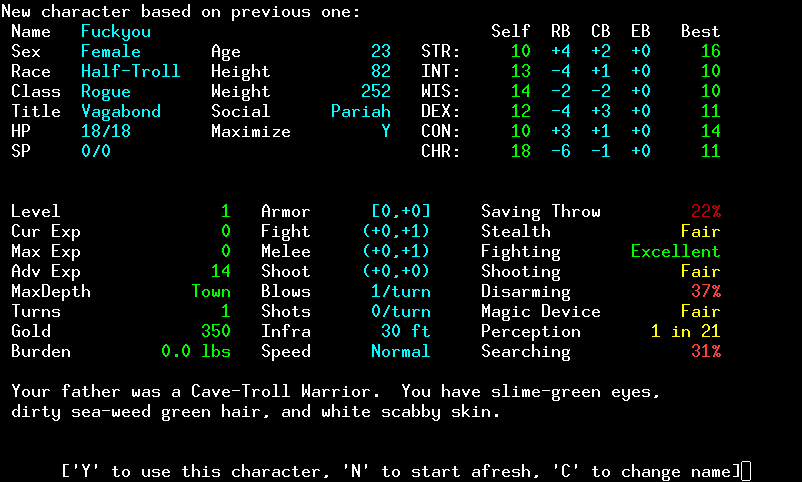
My last character, a half-troll, is resurrected for an umpteenth
attempt.
The commands are different from both Rogue and Nethack. At least the cursor keys work. When I start the game, I'm shown the documentation for the game. And yes, I will have to plough through this in order not to die within minutes due to using a wrong command. A period means "run", not "pick up". And reading a spellbook is different from studying a spell. On the up side, when I type a command that needs an inventory item, I'm offered a choice, which is great, because I don't know the letters of my inventory items off by heart.
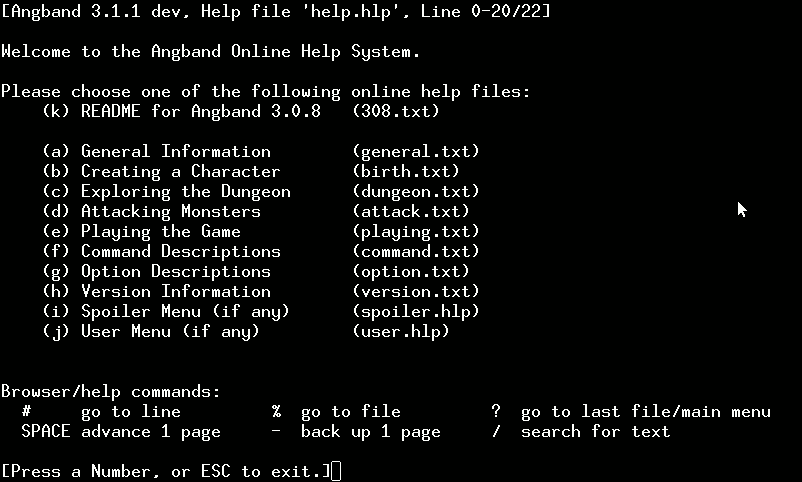
Please familiarize yourself with the game before entering it.
I start in a market square with numbered shops where I can stock up before going down the stairway represented by a ">". Some undesirables hang out there, like rogues and stray cats, but I can kill them or scare them off. I can't kill the clingy farmer who keeps asking me to collect his stolen mushrooms and to please not kill his poor dogs, and who loves to obstruct my way in and out of shops. I've met those dogs in the dungeon, even before I met the farmer. Man, they're strong. They kill me almost every time.
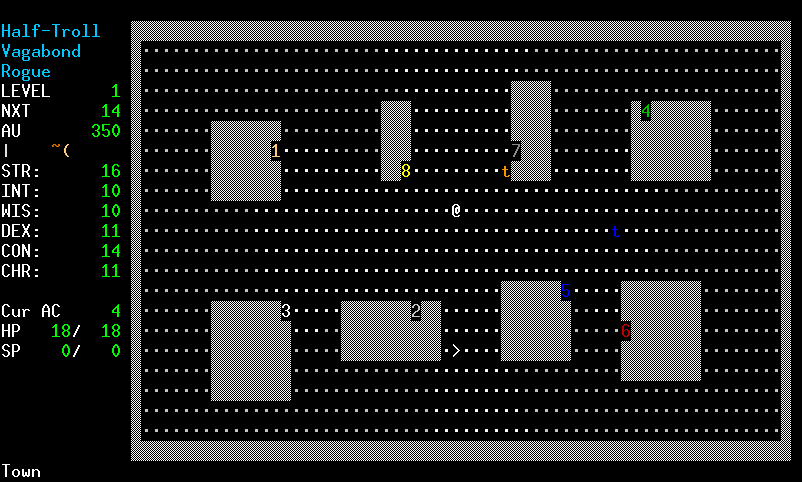
Every market square has a dungeon portal in it, don't you know.
The dungeon is so big that it doesn't fit on the screen, and scrolls to the side. This annoys me immensely, although at least the walls look more solid than in Rogue. The documentation already told me that I need to find and kill Morgoth at level 100. He's one m*f* opponent, so I have to get really, really strong by going down into dungeons lots of times, battling monsters, taking up as much loot as I can find, selling it to buy better equipment, going down in the dungeon again, etc. To my anguish, each time I go into the dungeon even on the same level, a new dungeon is generated. So, given that I might need to exit quickly to escape a dangerous monster (there are special scrolls for that) or can't carry all the loot I find and have to leave some behind, I can forget about cleaning out each level before moving to the next one. A monster that I didn't see in Nethack is "p", for "person", basically another adventurer, and something to avoid. Particularly the Novice Warrior, a tough opponent.
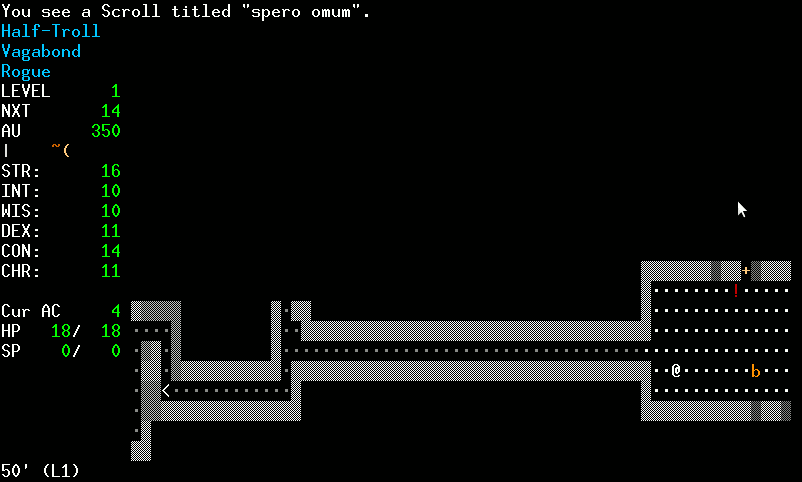
Whoops, scrolled off the side.
There are userfriendly aspects to the game, though. Like the help screen that acts like a control panel in an aeroplane, allowing me to check anything that might need checking, like the "level feeling". When I fight a monster (and this is something I could really have used in Nethack) I see the monster's "health bar" of asterisks. The game allows and to some extent automates the inscribing ("naming") of items. There are separate inscribing rules for "ego items", artifacts set apart from the normal weapons/tools to whose class they belong, to prevent mundane items from getting special properties. In all, it's not a bad game for someone who has a good enough memory to keep track of all the game features and player abilities, and who loves to dungeon-crawl mindlessly and neverendingly.
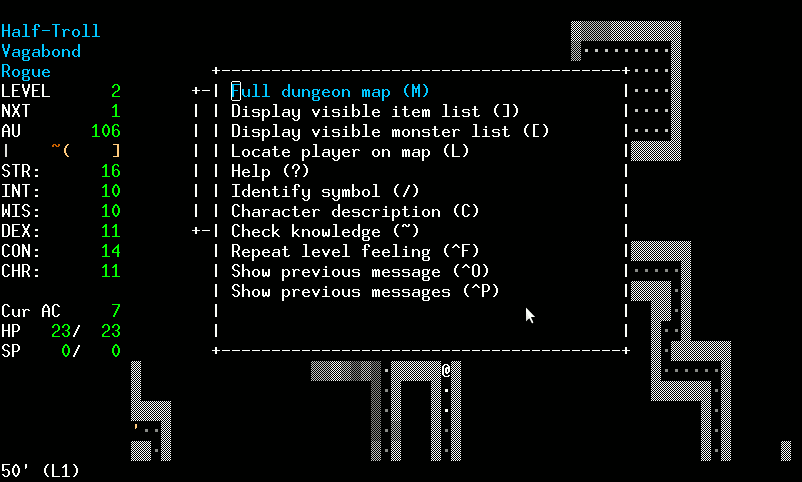
The handy help screen.
The manual of Crawl reads like an extended version of the spoiler text of Rogue. The documentation tells me that "Crawl was created in 1995 by Linley Henzell. Linley based Crawl loosely on Angband and NetHack, but avoided several annoying aspects of these games, and added a lot of original ideas of his own." Which annoying aspects would that be? I know the former has many, but haven't seen any in the latter, especially using the isometric interface. (Or would it be the annoying aspect of dying so fast every time? Nah... that's not an annoying aspect, that's a feature.) It appears that this is a fork called "Stone Soup" that tries to iron out the imbalanced parts of the game. The text continues: "The object of your quest in Crawl (the Orb of Zot) was taken from Wizard's Castle, a text adventure written in BASIC." Would that be "castle.zip" at the bottom of the More text adventures page?
The game asks you for a name straight away and offers, as opposed to a pile of texts to read, a tutorial. Although it does have its own docs, if you like a good read.
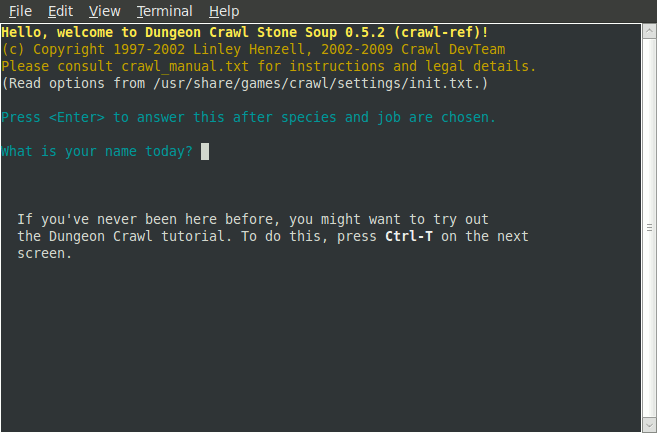
It then goes to race and class selection, still showing a reminder of that tutorial. Some of the races are rather whimsical: "Sludge Elf"?? It's possible to see the particulars of each race, which is good to check as in Crawl, the number of experience points needed for levelling is also variable and depending on race, and there are more special race qualities, and to top it off, each race can mutate, which can enhance or damage its skills, so there are potions of cure mutation. My head is spinning. The screengrab shows the screens for completely new characters; if I start over after a character has died, its name, race and class will be presented as defaults for the next game I start.
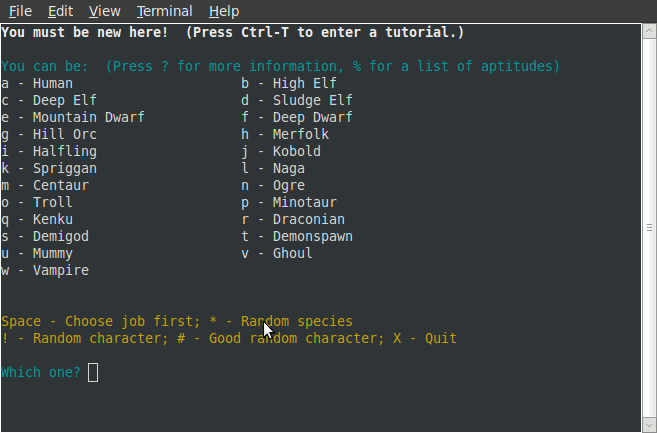
As shown by the screen below, player characteristics can take up more than one screen. After class and race are chosen, I can choose between several race- and class-related items by way of a starting kit. The choices for "Karu" include "enslavement", which makes a monster a temporary friend, the closest thing to a pet.
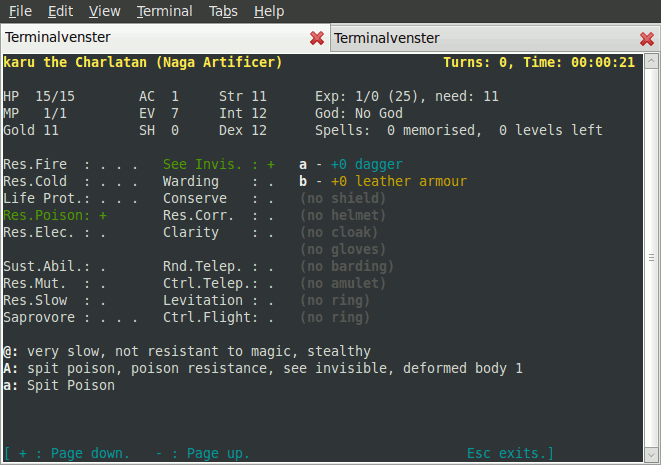
And bam, I'm in the dungeon. Sometimes rooms and corridors, sometimes just one big cave. It's like Angband in several ways: notably, the dungeon scrolls off the screen, especially since the bigger stats area leaves less room for the dungeon screen. I prefer how it uses text colour to make itself more legible, though. If I type a command that needs an inventory item, I'm offered a choice of what's available. There are ego items, and inscribing works the same. It also has a help screen to access all sorts of in-game information, but the info is displayed in the same screen, and doesn't open another terminal as in Angband.
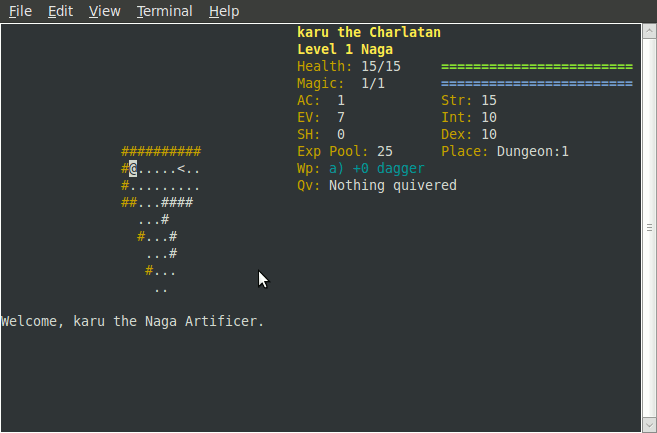
What's unlike Angband: I can move with both cursor and letter keys; it is possible to travel up and down between dungeon levels, ie. stairways don't disappear, and levels don't get re-generated each time the player enters them. This means that monsters standing next to the stairs can follow the player up or down. There are shops to buy new equipment, but you can't sell anything there, and can only carry 52 items, which means discarding a lot of loot, ouch! Monster corpses can be eaten, some traps can be disarmed, there are gods, altars and the possibility of praying, fast travel (hop from beginning to end square, and the game automatically takes the fastest route) and themed dungeon branches where to find Runes of Zot. There are wands (that have charges), staves (that are enhancers) and rods (that are "canned spells"). There are artifacts, that can't be enchanted (improved) or corroded (damaged). There is a complicated skills system that resembles Nethack; the highest general level a character can reach, as well as the highest level for each skill, is 27, and a skill level rise has to be "bought" with experience points, so the player has to choose a few skills to specialize in. The stats are for Strength, Dexterity and Intelligence (no Charisma, Wisdom or Luck) and if any of those stats hits zero, the player dies. The attributes are raised with every third rise in level. The aptitudes screen (press "%") tells me how many experience points I have, and how many I need to rise to the next level. There is a help screen (press "?") that gives access to all documentation and tells me which key opens what in-game information screen. There is a visible monsters/objects list (press Ctrl-X) that tells me if any of the monsters I see are asleep, or, if one monster is fighting me, how seriously wounded it is.
So, the game seems quite well thought out, combining the features of the previous roguelikes. Yet I found it too hard. Spells and thrown weapons can move in twisty lines, so it's not easy to get out of the fireline, and when I chose a Troll, a powerful race, so I wouldn't die so fast on level 1 (the lowest level I've ever reached) I was mobbed by all sorts of nasties, and died even sooner than usual! Conclusion: it's a good game. I'm just a bad player.
Since the Mint installation is where the Linux games are played, imagine my surprise when the SUSE repositories turned up not only the latest Vulture's, but also a graphical interface: "crawl-sdl". They were quickly installed and as quickly showed why the SUSE installation is not my first choice for games: neither would run. Since I can start the second by typing "crawl-sdl" in a terminal, I could see that the game wanted to create files in the "var" directory, but couldn't. Fair enough, the game instructions did say my user had be in the group "games". User added to group, still no luck. Turns out that "var" is only accessible to root. Too tired/lazy to sort out the rights matter, I simply made my user join the group "root", thereby hugely compromising security - but how often am I online anyway? And after that, Vulture's started too. Hallelujah. (After a while, I became queasy at the security risk, removed my username from the group "root", and did what I should have done in the first place: added the group "games" to "/var" and "/var/games" under "Advanced permissions".)
So, what does this interface look like? Here's a shrunk pic of the whole (non-windowed, monitor-filling) screen:

Cut up into its parts: first, the dungeon, in this case of the tutorial (where I still managed to off myself, how noob is that) showing a little avatar that changes as I equip weapons and armour. As such, despite its greater simplicity, it is actually slightly superior to Vulture's, which only shows me what species I am. Here I'm just starting, but as I explore, the area will expand, scrolling off the screen. Fortunately, there's a little mini-map under the stats section.
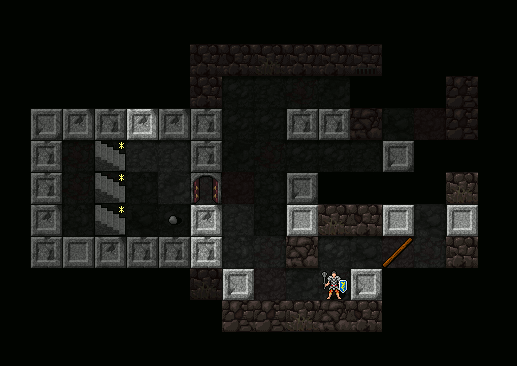
The stats section, with health/magic bars and the aforementioned minimap. Nope, being a Demigod didn't help me last any longer.
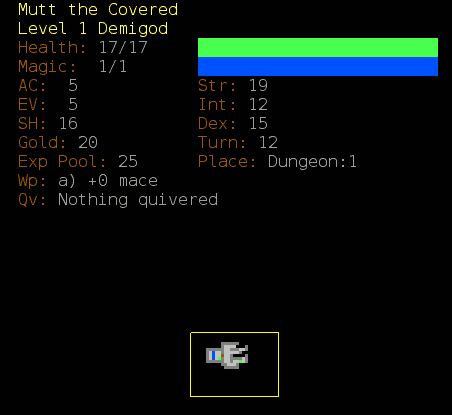
The message area. It is possible to recall all the old messages by double-clicking on this area. Handy when missing an instruction during the tutorial because of all the messages displayed when I'm swamped with rats.

The inventory! At least, the top tab is the inventory. Underneath the inventory squares, I see all objects I'm standing on and could pick up. The next two tabs are for spells and spellbooks, and the bottom-most tab gives me information on monsters close to me.
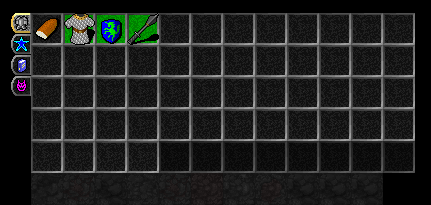
This interface has changed the game from (to me) unplayable to almost playable: I even managed to get as far as dungeon level 2! Yes, that does sound too pathetic to be a proper recommendation...
Update: Dungeon Crawl Stone Soup with tile interface in openSUSE 13.2 is at version 0.14, and the latest version as of March 2015 is 0.16. Since this game is constantly updated, a few races from the character creation screenshot have already been removed or renamed, and others added. It seems Crawlers consider themselves and their game superior to Nethackers, to which I disagree - the latter have far more interactivity with objects, they can mix potions and store items in containers, and items can be sold, rather than lying about littering the dungeon - but the former face far prettier visuals, which, unlike Vulture's (though it's mean of me to say so) are complete: no species tiles are missing. Let me wax lyrical on the subject of Crawl tiles for a moment: tiny though they are, they look neater and more professional than the Vulture tiles (especially my own submissions, hm), possibly because they are so small, yet cram so much detail in. The player tile not only changes to reflect any change in gear or weapon, but can be further customized (not that I've bothered, the default suits me fine). The dungeon layouts somehow look more imaginative, and, due to plants/trees/fungi having more than just one tile each, more varied: ooh, those swamps, those underground gardens. And the different altars, mmm, I could just kiss them. For examples of pretty visuals (click on the cutouts for the larger pictures) here are: a small wooded room, a large room with a formal garden look and - the biggest image of them all - the most inclusive layout (in version 0.14) of the Ecumenical Temple.
I'm also managing to survive to level 7 or so thanks to the travel guides (or
"spoilers" as some curmudgeons would say) provided by the
Crawl wiki.
Typing "tome" opens about eight terminals, four lying on another four. The top left terminal is the actual game screen. Are the rest for game output, or is it just a bug? I never gamed long enough to find out.
In ToME, the player doesn't just go into dungeons to grab loot. Oh no. There is a village to go to and from there, a set route to follow. As if the screen filling up with terminals wasn't enough to deter me, when I do work up the courage to play the game, I get stuck on the character creation. There are many races to choose from, and three states, including "undead". They can be combined with classes any way you like, although some combinations - like my Ent chosen for toughness, and given a magic-user class - are bound to fail. Then, I get stuck again in what I'll call the shopping centre. It's no good dungeon-crawling if there's no shops to stock up on equipment and sell loot. The shops have numbers and I'll just have to guess which is what, or use some key to tab around and ask for information. Lepers and other nasty town locals follow me around and block my way. I buy a spellbook, follow the orders to descend in some dungeon and almost die because I didn't figure out the right succession of keys to read a spell from the book. You know what: stuff it. Crawl is better than this. Nethack is incredibly much better than this, simply because making a character and using items is simpler. Game developers want to add more and more possibilities to the game, and as they do so, it becomes more and more unwieldy, and the learning curve steeper to vertical. I can see why people who took the time to completely figure it out would absolutely love this game. But I don't have that kind of commitment.
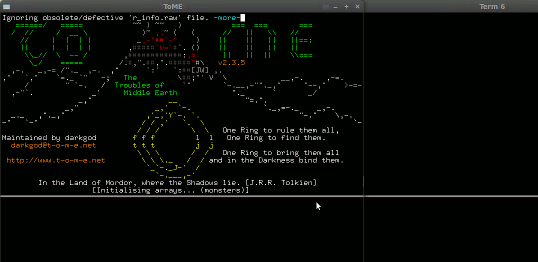
The main screen, surrounded by many overlapping terminals.
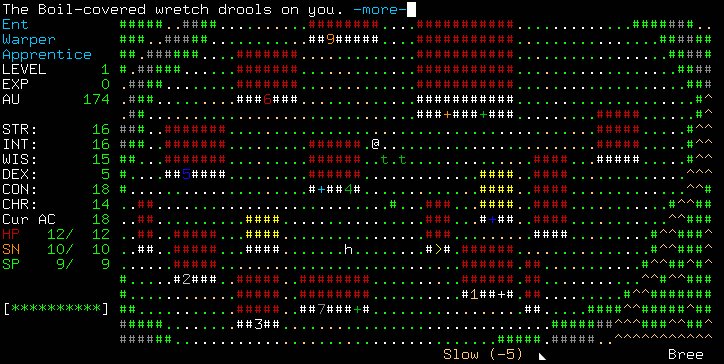
While you are in town shopping, wretches and lepers may drool on you.
Sadly, they are unkillable.
Lastly, ProgressQuest, though not a roguelike, is a non-participation game and spoof of dungeon-crawlers where the player starts the game (from the menu, this is not an ASCII game) with the creation of a character chosen from some outright ridiculous options, and then sits back watching the screen fill up with absurd messages of that character's "progress". It's a fun game to play after a nerve-wracking dungeon crawl ending in a frustratingly stupid death.
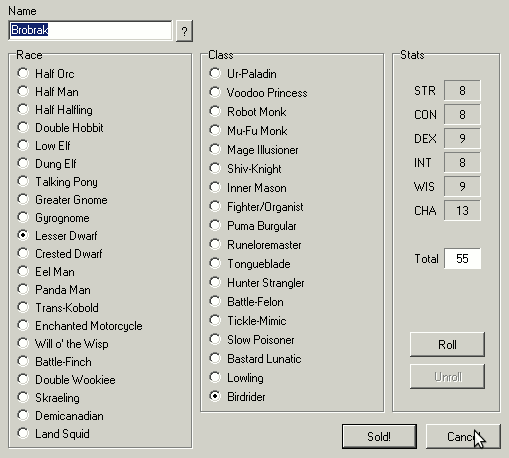
Such a multitude of appealing races and classes to choose from.
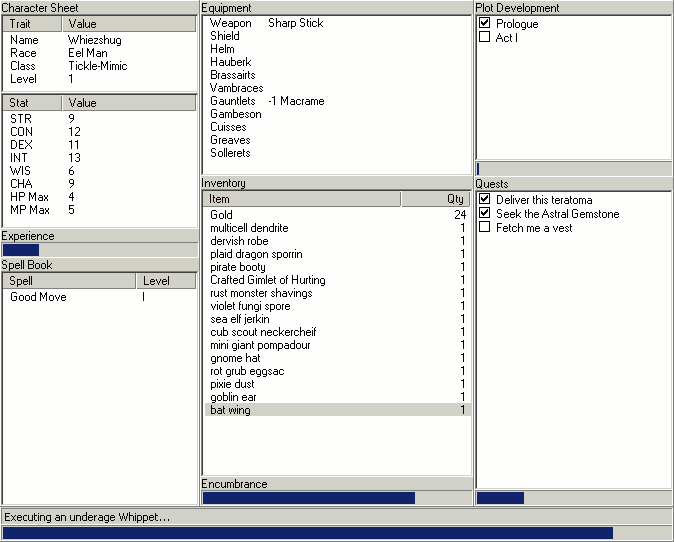
Oh no! Not the underage Whippet!


